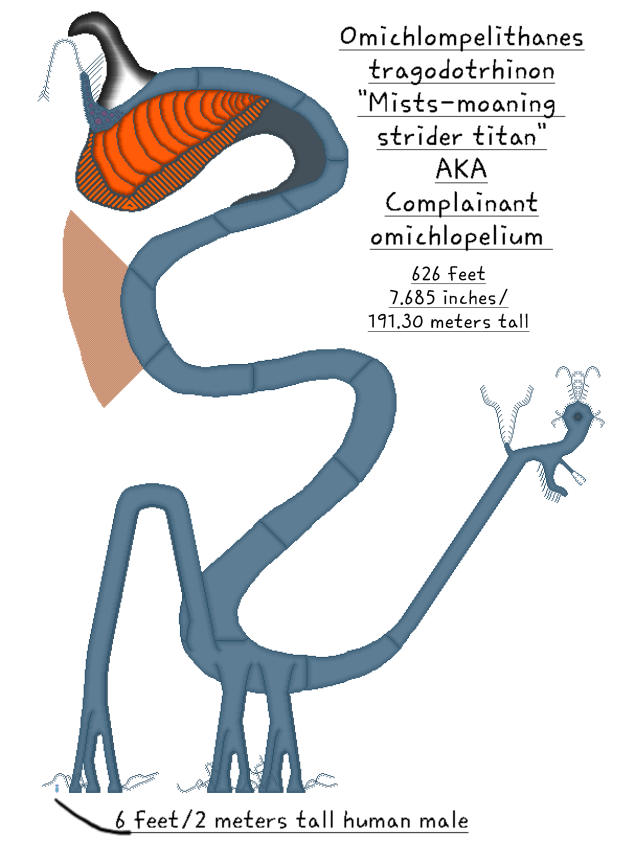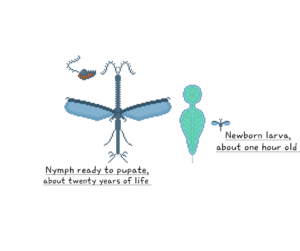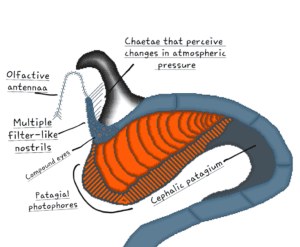
On the planet, Nibbio, life can reach titanic proportions, and towering above all is the mighty Mist Strider Titan.
Yet this massive creature begins its life as a minute boneless larva that feeds on decomposing plant material. Over time, it passes through various molts and two main chrysalises. The first chrysalis occurs around the age of one and transforms the boneless winged larva, now the size of a sheep, into a cow-sized animal that possesses bones and characteristics found in its adult form, as well as two additional limbs pair (in the image, the front pair is hidden by the wings).
 In this second stage, it is a carnivorous nymph and feeds on small animals mainly aquatic fishes through the structures which in its full adult form will evolve into baleen plates. In both these forms, the animal lacks a genital system, therefore not being classifiable in a defined sex. Only after about twenty years in the nymph stage is the animal ready for the second chrysalis, which will lead to a sub-adult individual the size of a giraffe.
In this second stage, it is a carnivorous nymph and feeds on small animals mainly aquatic fishes through the structures which in its full adult form will evolve into baleen plates. In both these forms, the animal lacks a genital system, therefore not being classifiable in a defined sex. Only after about twenty years in the nymph stage is the animal ready for the second chrysalis, which will lead to a sub-adult individual the size of a giraffe.
Between subadult and adult specimens, there is a habitat partition based on size: from 19 to 98 feet (6 to 30 m), they live on plateaus and in dry areas in general, from 98 to 230 feet (30 to 70 m) they live in swampy environments, where the water, however shallow, helps to keep them stable, finally, exceeding this size, they began to move into deeper waters as it is the only biome where they can support their weight.
Males can be distinguished from females by their straight, ever-growing horns; females, in contrast, have forward-curving horns. These horns are made of bone, hence the dark color, and have a skin covering in the center of which there is a series of photophores that generate white light. This light, together with the size of the horn, allows the females to understand if the males are healthy and hence fit for breeding. According to some hypotheses, and judging also from the analyses done on the nymphs developing in the chrysalis, the horn serves the mini-adult newborn for splitting the hard surface of the chrysalis, and whilst in the females it is lost, in the males it is kept. Researchers speculate this mechanism to be the same as one by which the horn in some types of Earthen beetle evolved.
The animal’s walking posture is with the body held in several folds, as it helps to cushion its weight at each step. To support its bulk, it has evolved bones with honeycomb structures that are internally pneumatized. These characteristics allow it to grow to a considerable size while still managing to move despite the gravity of the planet. The honeycomb structure is light yet solid, and the pneumatization serves to further lighten the body. The legs, only six, are columnar and have the heaviest and densest bones of the body (which are in any case hollow) and serve to support the enormous weight of the animal. The toes, four per foot, function as independent paws which are held in a digitigrade position and mostly spread apart in order to better disperse the weight on the ground.
All in all, these adaptations mean the animal is relatively light compared to its size, weighing just 340 tons. The metabolism is low, due both to the partial lethargy of the animal, stimulated by the lack of predators and the abundance of its food, and to the low temperatures of the planet. This feature allows the animal to age very slowly and to digest every last nutrient from what it ingests.
The toes each have a sensory tendril at the tip, which serves to scan and explore what lies at their feet so as not to misstep into submerged crevasses or excessively muddy surfaces that could cause them to fall.
Its adult and sub-adult diet, like every member of its order, is composed entirely of particulate matter floating in the atmosphere and planktonic animals which it captures by means of the retractable baleen plates which exit from the oral segment. These baleen plates are used for the purpose of hydration. The mist on these baleen ends up condensing into droplets which, thanks to the grooves in the baleen itself, are conveyed towards the mouth.
These animals communicate with each other over long distances through sounds similar to painful moans and mumbling produced by the air that is expelled from the nostrils in various intensities. The close-range communication method is composed of intermittent sequences of bio-lights placed on the cephalic patagium.
 These creatures feature compound eyes with silicon lenses, which serve to protect the receptors capable of perceiving light and color from excessive humidity in the atmosphere. These receptors only perceive polarized light, which is very useful in a mostly sunlight-free environment like Nibbio. By sensing polarized light, they are able to see the shadows and outlines of other life forms and the environment around them, which helps them navigate fog even without a bio-sonar.
These creatures feature compound eyes with silicon lenses, which serve to protect the receptors capable of perceiving light and color from excessive humidity in the atmosphere. These receptors only perceive polarized light, which is very useful in a mostly sunlight-free environment like Nibbio. By sensing polarized light, they are able to see the shadows and outlines of other life forms and the environment around them, which helps them navigate fog even without a bio-sonar.
The chaetae on the head are especially useful for adults to understand at what altitude they are, so as not to end up in elevated places. This is useful as their lungs, adapted during growth to the quantity of oxygen present in the oceanic depressions, would not be able to extract sufficient oxygen from the thinner atmosphere to nourish the immense organism. The air is inhaled through a long “grate” of pointed nostrils placed on the head and conveyed into the lungs which occupy half the body’s capacity. These lungs serve to inhale the necessary amount of oxygen they need, and at the same time also to lighten the body even more. The pointed nostrils are filled with thick hairs that act as a filter to prevent the innumerable bacterial masses typical of a super-Earth planet from entering the lungs and causing serious infections. This filter also works against unnecessary excess moisture in the lungs.
Due to their size, they do not have predators as adults. At this stage, the most frequent cause of death is them collapsing onto themselves as grow too large and can no longer move their weight for the environment. Thereafter, they eventually die from starvation as their immediate environment runs out of food.
This entry was created by community member, Zarekay56